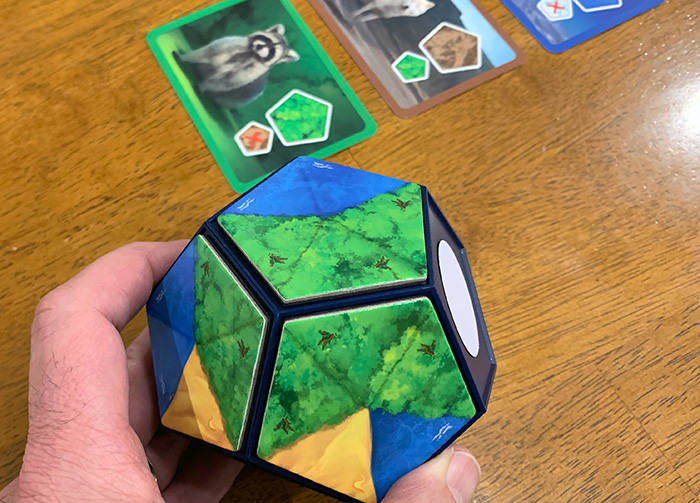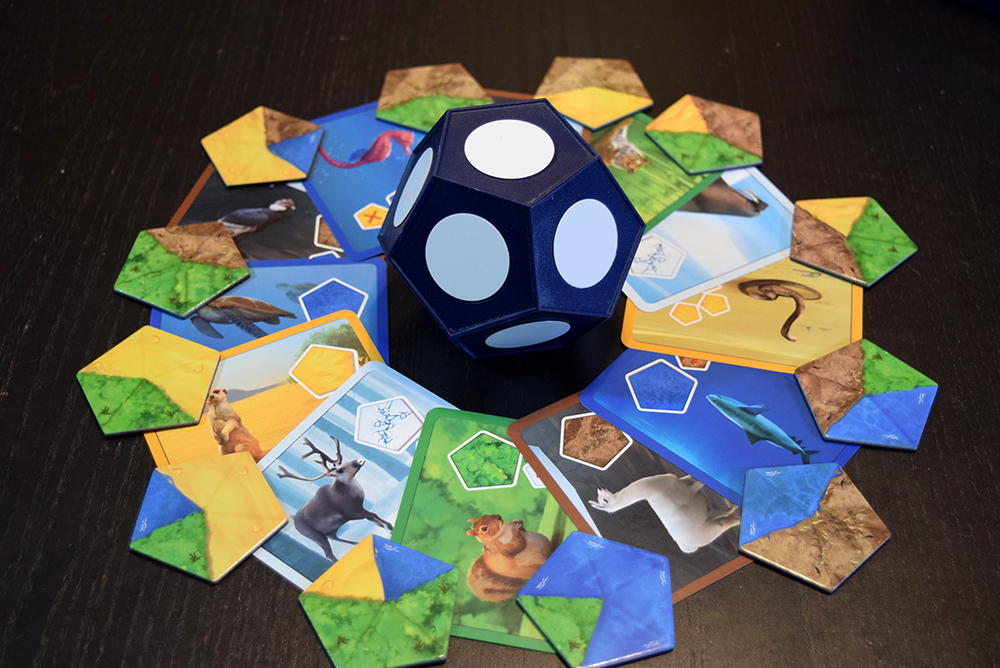
A whole world in the palm of your hand. No other board game can really capture the same sense of tactile control that Planet achieves from the get-go. The feeling of rolling a continuous gameboard between your hands is striking – for novice and experienced players alike. However, the question worth asking is this: is Planet a good game with a unique board, or a bad game with a gimmicky board?
At its core, Planet is a tile-placement game similar to Carcassonne or Azul. Players place tiles on a spherical board to create contiguous regions of various biomes. These biomes allow players to house animal species that score points based on the difficulty of their acquisitions. And… that’s it. Planet has no real player engagement, diverse strategy, or anything else to add a sense of replayability. To be entirely fair, there are certainly moments of deliberation, and we often found ourselves thinking for a minute about which tiles our globe needed most (it’s worth noting that much of this deliberation arose from the difficulty of parsing a tiled globe).
The Good:
The concept and execution of the spherical board in Planet is by far the best part of the game. While I have problems with the practicality and readability of the board, the Planet itself is undeniably cool. As someone who has played hundreds of board games, opening the planet box was akin to Neo waking up outside the Matrix for the first time. In an incredibly literal sense, Planet adds another dimension to the traditional board game. Defying the expectation of a single-plane playspace makes everything feel more real. Placing tiles on your board truly feels like terraforming a new world. Additionally, taking a game genre that already feels meditative and adding a very strong sense of tactility creates a very pleasant experience. Other than moments of intercontinental gridlock, rotating the board and attaching beautifully illustrated hexagons feels elegant and soothing. For people drawn to tactile experiences or toys, this game could easily have more appeal than a traditional board game. I can see this game serving as a very effective gateway game for kids or adults with less board game experience.
The Bad:
Though this section is titled “The Bad”, it seems unfair to poorly review the game for not being something that it never set out to be. Instead, the reasons here explore why Planet is not the game for me. In truth, I am not the biggest fan of tile placement games in general. I certainly play them when someone offers, but they have never been my cup of tea. I prefer games that allow players diverse options and methods of interaction. However, my reason for not shunning the tile-placement genre entirely can be attributed to one gameplay feature: the communal board. The simple decision of condensing numerous player boards into one opens up levels of strategy and diversity. Sadly, Planet’s unique board setup makes a communal board impractical – if not impossible. This limits the inter-player interaction to the pursuit of a shared tile/goal pool. While this does add more depth, for me it primarily added frustration. There is no way to play around turn order, so players can easily block others from achieving their goals with no counterplay. For me, this takes most of the fun out of the game, and it devolved into focusing on goals that nobody else wanted. Though this strategy proved to be a winning one, it was certainly not a fun one.
Overall:
Planet is a game with a very simple, but equally well-executed, premise. The board is the standout of the game, but for me personally, it wasn’t enough to make Planet worth playing. On the whole, I’m hesitant to write off the unique board as a gimmick. I think that Planet does offer a twist on the tile-placement format that sets it apart from the rest. Unfortunately, this twist may be insufficient to elevate it to the status of its better-known peers.
